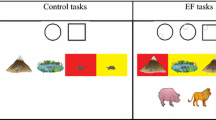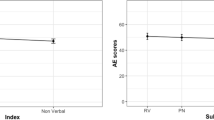Abstract
Hospitalized schizophrenic (N=15) and nonschizophrenic (N=18) youngsters were compared on measures of verbal and imagery development as well as on four paired-associate learning tasks involving combinations of word and picture stimuli pairs. The results showed the schizophrenic group to be similar to the controls on verbal and full-scale intelligence measures but significantly inferior on performance measures. The schizophrenic group also showed a general disadvantage in paired-associate learning, with a trend toward specific differential difficulty with words as stimulus items. Results suggest the presence of nondominant hemisphere deficit in the target group and also provide weak support for theories of dominant hemisphere dysfunction in schizophrenia.
Similar content being viewed by others
Reference notes
Martz, M. J., & Alpert, M. Unpublished data.
Goldberg, E. Personal communication, August 1980.
Reference
Alpert, M., & Anderson, L. T. Imagery mediation of vocal emphasis in flat affect.Archives of General Psychiatry, 1977,34, 208–212.
Alpert, M., & Martz, M. J. Cognitive views of schizophrenia in light of recent studies of brain asymmetry. In C. Shagass, S. Gershon, & A. J. Friedhoff (Eds.),Brain dysfunction and psychopathology. New York: Raven Press, 1976.
Beaumont, J. G., & Dimond, S. J. Brain disconnection and schizophrenia.British Journal of Psychiatry, 1973,123, 661–662.
Bleuler, E.[Dementia praecox or the group of schizophrenias] (J. Zinkin, Trans.). New York: International Universities Press, 1950.
Bruner, J. S., Oliver, R. R., & Greenfield, B. M.Studies in cognitive growth. New York: Wiley, 1966.
Chapman, L. J., & Chapman, J. P.Disordered thought in schizophrenia. New York: Appleton-Century-Crofts, 1973.
Cohen, B. D. Referent communication disturbances in schizophrenia. In S. Schwartz (Ed.),Language and cognition in schizophrenia. Hillsdale, New Jersey: Erlbaum, 1978.
Creak, M. Childhood psychosis.British Journal of Psychiatry, 1968,109, 84–89.
Dilley, M. G., & Paivio, A. Pictures and words as stimulus and response items in paired-associate learning of young children.Journal of Experimental Child Psychology, 1968,6, 231–240.
Ervin, S. Changes with age in the verbal determinants of word-association.American Journal of Psychology, 1961,74, 361–372.
Finch, F. H., & Kuhlman, F. Kuhlmann-Finch scholastic aptitude tests manual. Minnesota: American Guidance Service, 1956.
Flor-Henry, P. Psychoses and temporal lobe epilepsy: A controlled investigation.Epilepsia, 1969,10, 363–395.
Forisha, B. Mental imagery and verbal processes: A developmental study.Developmental Psychology, 1975,11, 259–267.
Friedhoff, A. J., & Alpert, M. The effect of chlorpromazine on the variability of motor task performance in schizophrenics.Journal of Nervous and Mental Disease, 1960,130, 110–116.
Gruzelier, J., & Hammond, N. Schizophrenia: A dominant hemisphere temporal-limbic disorder?Research Communication in Psychology, Psychiatry and Behavior, 1976,1, 33–72.
Kuhlman, C. K.Visual imagery in children. Doctoral dissertation, Radcliffe College, 1960.
Likert, R., & Quasha, W. Revised Minnesota paper form board test. New York: Psychological Corporation, 1969.
Magaro, P. A. Theories of the schizophrenic performance deficit: An integration theory synthesis. In B. Maher (Ed.),Progress in experimental personality research (Vol. 7). New York: Academic Press, 1974.
McDowell, D., Reynolds, B., & Magaro, P. The integration defect in paranoid and non-paranoid schizophrenia.Journal of Abnormal Psychology, 1975,84, 629–636.
Mednick, S. A., & Schulsinger, F. A. A longitudinal study of children with a high risk for schizophrenia: A preliminary report. In S. Vanderberg (Ed.),Methods and goals in human behavior genetics. New York: Academic Press, 1965.
Paivio, A.Imagery and verbal processes. New York: Holt, Rinehart & Winston, 1971.
Paivio, A., & Yarmey, A. D. Pictures versus words as stimuli and responses in paired-associate learning.Psychonomic Science, 1966,5, 235–236.
Piaget, J., & Inhelder, B.Mental imagery in the child. New York: Basic Books, 1971.
Shimkunas, A. Hemispheric asymmetry and schizophrenic thought disorder. In S. Schwartz (Ed.),Language and cognition in schizophenia. Hillsdale, New Jersey: Erlbaum, 1978.
Stewart, J. C.An experimental investigation of imagery. Doctoral dissertation, University of Toronto, 1965.
Thurstone, T. Examiner's manual, primary mental abilities. Chicago: Science Research Associates, 1963.
Author information
Authors and Affiliations
Additional information
This research was supported by a postdoctoral research fellowship awarded to Dr. Linda Carter by the National Institute of Mental Health (Grant MHO 2875). Dr. Alpert was the sponsor of this training grant.
Rights and permissions
About this article
Cite this article
Carter, L., Alpert, M. & Stewart, S.M. Schizophrenic children's utilization of images and words in performance of cognitive tasks. J Autism Dev Disord 12, 279–293 (1982). https://doi.org/10.1007/BF01531373
Issue Date:
DOI: https://doi.org/10.1007/BF01531373




